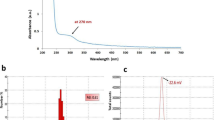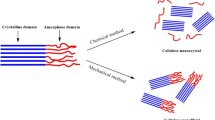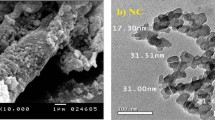Abstract
The present study reports the preparation of nanocrystalline cellulose (NCC) with further reinforcement using succination and amination to observe the unexploited sorption efficiency of chromium from water bodies. The increased surface area-to-volume ratio of nanoparticles, quantum size effects, and the ability to tune surface properties through molecular modification make NCC ideal for metal remediation. Novel NCC was also characterized on the basis of XRD and AFM techniques and found to have enough potential for functionalization. Fourier transform infrared spectrometry of functionalized biomass highlights NCC interactions with succination and amination reactions, responsible for sorption phenomenon of chromium. Sorption studies (batch experiments) result into the standardization of optimum conditions for removal of Cr(III) and Cr(VI) as follows: biomass dosage (2.0 g), metal concentration (25 mg/l), contact time (40 min), and volume of the test solution (200 ml) at pH 6.5 and 2.5, respectively. The adsorption data were found to fit both the Freundlich and Langmuir isotherms. The sorption capacity of the regenerated biomass remained almost constant after five cycles of sorption process, suggesting that the lifetime was sufficient for continuous application and was further confirmed by means of TGA analysis. Artificial neural networks model was developed to predict the removal efficiency of Cr(III) and Cr(VI) ions from aqueous solution using functionalized NCC. Back-propagation and Levenberg–Marquardt techniques are used to train various neural network architectures and the accuracy of the obtained models using test data set. The optimal neural network architectures of this process contain 15 and 16 neurons for Cr(III) and Cr(VI) respectively, with minimum mean-squared error for training and cross validation as for Cr(III) 1. 6.46422 × 10−6 and 0.001137496 and for Cr(VI) 1. 30386 × 10−6 and 0.002227835, respectively.











Similar content being viewed by others
References
Bailey SE, Olin TJ, Bricka RM, Adrian DD (1999) A review of potentially low cost sorbents for heavy metals. Water Res 33:2469–2479
Bhattacharya AK, Naiya TK, Mandal SN, Das SK (2008) Adsorption, kinetics and equilibrium studies on removal of Cr(VI) from aqueous solutions using different low-cost adsorbents. J Chem Eng 137:529–541
Calace N, Muro DA, Nardi E, Petronio BM, Pietroletti M (2002) Adsorption isotherms for describing heavy metal retention in paper mill sludges. Ind Eng Chem Res 41:5491–5497
Cieslak-Golonka M (1995) Toxic and mutagenic effects of chromium(VI). Polyhedron 15:3667–3689
Colvin VL (2003) The potential environmental impact of engineered nanomaterials. Nat Biotech 10:1166–1170
Dhermendra KT, Behari J, Prasenjit S (2008) Application of nanoparticles in waste water treatment. Water Air Soil Pollut 3:417–433
Dieter K, Brigitte H, Hans-Peter F, Andreas B (2005) Cellulose: fascinating biopolymer and sustainable raw material. Polymer Sci 44:3358–3393
Egila JN, Dauda BEN, Iyaka YA, Jimoh T (2011) Agricultural waste as a low cost adsorbent for heavy metal removal from wastewater. Int J Phys Sci 6:2152–2157
Goyal P, Srivastava S (2009) Characterization of novel Zea mays based biosorbent designed for toxic metals biosorption. J Haz Mat 172:1206–1211
Ioelovich M (2012) Optimal conditions for isolation of nanocrystalline cellulose particles. J Nanosci Nanotechnol 2(2):9–13
Jalali R, Ghafourian H, Asef Y, Davarpanah SJ, Sepehr S (2002) Removal and recovery of lead using non living biomass of marine algae. J Haz Mat 92(3):253–262
Kardam A, Raj KR, Arora JK, Srivastava MM, Srivastava S (2010) Artificial neural network modeling for sorption of cadmium from aqueous system by shelled Moringa oleifera seed powder as an agricultural waste. J Water Resour Prot 2:339–345
Kardam A, Raj KR, Arora JK, Srivastava S (2011a) ANN modeling on predictions of biosorption efficiency of Zea mays for the removal of Cr(III) and Cr(VI) from waste water. Int J Math Trends Technol 2:23–29
Kardam A, Raj KR, Arora JK, Srivastava S (2011b) Ann modeling on predictions of biosorption efficiency of Zea mays for the removal of Cr(III) and Cr(VI) from waste water. Int J Math Trends Technol 2:23–29
Lee KY, Quero F, Blaker JJ, Hill CAS, Eichhorn SJ, Bismarck A (2011) Surface only modification of bacterial cellulose nanofibres with organic acids. Cellulose 18:595–605
Ma H, Burger C, Hsiao BS, Chu B (2011) Ultra-fine cellulose nanofibers: new nano-scale materials for water purification. J Mat Chem 21:7507–7510
Mamadou SD, Savage N (2005) Nanoparticles and water quality. J Nano Res 7:325–330
Owlad M, Aroua MK, Daud WAW, Baroutian S (2009) Removal of hexavalent chromium-contaminated water and wastewater: a review. Water Air Soil Poll 200(1–4):59–77
Park YS, Chon TS, Kwak IS, Lek S (2004) Hierar-chical community classification and assessment of aquatic ecosystems using artificial neural networks. Sci Total Environ 327(1–3):105–122
Park S, Baker JO, Himmel ME, Parilla PA, Johnson DK (2010) Cellulose crystallinity index: measurement techniques and their impact on interpreting cellulase performance. Biotec Biofuel 3:10
Paul GT, Richard LJ (2006) Nanotechnologies for environmental cleanup. Nanotoday 1:44–48
Prakash A, Kumar U, Kumar K, Jain VK (2011) A wavelet-based neural network model to predict ambient air pollutants concentration. Environ Model Asses 16:503–517
Raji C, Anirudhan TS (1998) Batch Cr(VI) removal by polyacrylamide-grafted sawdust: kinetics and thermodynamics. Water Resour 32(12):3772–3780
Rickerbya DG, Morrison M (2007) Nanotechnology and the environment: a European perspective. Sci Technol Adv Mat 8:19–24
Saha W, Edwards KL (2007) The use of artificial neural networks in material science based research. Mater Des 28:1747–1752
Sharma P, Kumari P, Srivastava MM, Srivastava S (2007) Ternary biosorption studies of Cd(II), Cr(III) and Ni(II) on shelled Moringa oleifera seeds. Bioresour Technol 98:474–477
Shetty GR, Chellam S (2003) Predicting membrane fouling during municipal drinking water nanofiltration using artificial neural networks. J Membr Sci 217(1–2):69–86
Srivastava S, Goyal P (2010) Decontamination of toxic metals from wastewater. Springer, Heidelberg
Srivastava MM, Chauhan A, Kumari P, Sharma P, Srivastava S (2005) Adsorption behavior of cadmium and nickel from aqueous solution by Saraca indica Linn. leaf powder. Arch Environ Prot 31(3):59–69
Sugashini S, Meera Sheriffa Begum KM (2013) Column adsorption studies for the removal of Cr(VI) ions by ethylamine modifed chitosan carbonized rice husk composite beads with modelling and optimization. J Chem. doi:10.1155/2013/460971
Tanyildizi MT (2011) Modeling of adsorption isotherms and kinetics of reactive dye from aqueous solution by peanut hull. Chem Eng J 168(3):1234–1240
Tiravanti G, Petruzzelli D, Passiono R (1997) Pretreatment of tannery wastewaters by an ion exchange process for Cr(III) removal and recovery. Water Sci Technol 36:197–207
Ucun H, Bayhan YK, Kaya Y, Cakici A, Algur OF (2002) Biosorption of chromium(VI) from aqueous solution by cone biomass of Pinus sylvestris. Bioresour Technol 85:155–158
Vankar PS, Tiwari V (2002) Phytofiltration of toxic metals ions by Portulaca oleracea, J Analyt Chem, Reference Number AAS001
Wiesner MR, Lowry GV, Alvarez P, Dionysiou D, Biswas P (2006) Assessing the risks of manufactured nanomaterials. Environ Sci Technol 40:4336–4345
Zimmermann T, Bordeanu N, Strub E (2010) Properties of nanofibrillated cellulose from different raw materials and its reinforcement potential. Carbohydr Poly 79:1086–1093
Acknowledgments
The authors are thankful to Director, Dayalbagh Educational Institute, Dayalbagh, Agra, for providing necessary research facilities. The main author Kiran Singh is also grateful to UGC-BSR (New Delhi), for rendering financial assistance.
Author information
Authors and Affiliations
Corresponding author
Rights and permissions
About this article
Cite this article
Singh, K., Arora, J.K., Sinha, T.J.M. et al. Functionalization of nanocrystalline cellulose for decontamination of Cr(III) and Cr(VI) from aqueous system: computational modeling approach. Clean Techn Environ Policy 16, 1179–1191 (2014). https://doi.org/10.1007/s10098-014-0717-8
Received:
Accepted:
Published:
Issue Date:
DOI: https://doi.org/10.1007/s10098-014-0717-8




